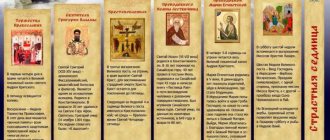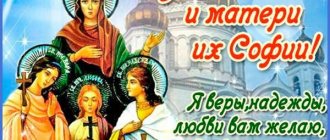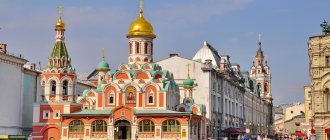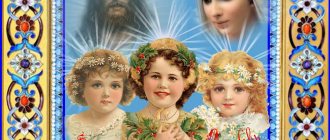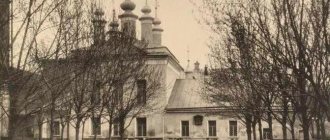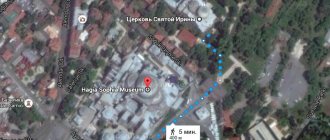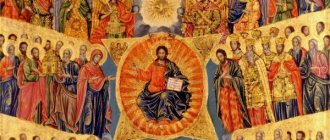Home › Holidays
| Date in 2022 | September 30, 2022, Friday |
| Church name: | Martyrs Faith, Hope, Love and their mother Sophia |
| Meaning: | Honoring the memory of Saint Sophia and her daughters Vera, Nadezhda and Lyubov |
| Other names: | Ecumenical women's name day, All-secular Indian holiday, Indian howl, Maiden's holiday |
| Traditions: | General crying, village calendars (gatherings) in order to find the bride or groom |
History of the holidayTraditions and ritualsSigns
The Day of Faith, Hope and Love is celebrated by Orthodox Christians every year on September 30th. This holy date is dedicated to three sisters and their mother Sophia, who were tortured but did not renounce Christianity. In all churches on this day, prayer services are held in their honor; women pray at the icons of martyrs for pregnancy and the healing of sick children.
history of the holiday
In the first half of the 2nd century, when Emperor Hadrian was the ruler of Rome, a widow named Sophia settled in this city. She lived with her daughters - Vera, Nadezhda, Lyubov. Their mother gave them these names because these were the names of the main Christian virtues. Sophia was a devoted Christian, and she raised her children to honor Jesus Christ. The Roman government at that time brutally persecuted Christians. One day, the emperor became aware of the sisters, whom everyone in the city loved for their beauty and wisdom. He wished to see Sofia's daughters.
Talking with them, Adrian saw how firm the young maidens were in their faith. The emperor decided that by talking to each of the sisters separately, it would be easier for him to shake their faith in Christ. The eldest of the sisters, 12-year-old Vera, was the first to be brought to the tyrant. The emperor addressed her with a flattering speech, but this did not bribe the courageous girl. She openly stated that she considered the way Adrian treated Christians to be criminal. The enraged emperor threw Vera to the executioners, who tore off her clothes and scourged her mercilessly. Then the girl had both breasts cut off, and the wounds began to ooze milk instead of blood. Terrible torture did not break Vera - she was supported by God's power. Then, by order of the ruler, she was beheaded.
Next, 10-year-old Nadezhda appeared before the emperor. Neither the admonitions nor the threats of the emperor could force her to renounce Christ. The executioners whipped Nadezhda, and then decided to burn her alive in an oven. But the fire suddenly went out. And this sister’s head was also cut off. When Lyubov, who was nine years old, was brought to Adrian, his attempts to force the girl to renounce Christ also failed. The emperor was very angry that he could not break the spirit of the young Christian women. And the youngest of the sisters was subjected to terrible torture: first they crucified her on her hind legs, twisting all the joints on her limbs. Then the crippled child was dragged into a burning oven, but an angel saved Love from burning. They could kill her only by cutting off her head.
All these savages happened before Sofia’s eyes. Adrian decided that there was no point in torturing her - Sofia still would not give up her beliefs, even if the torment and death of her own children did not prompt her to do so. The emperor gave the bodies of the young martyrs to the mother, and she, placing the remains on a chariot, left the city. On the outskirts, Sofia buried her tortured children and remained at the grave to mourn them. Three days later, her soul went to the Lord. Believers buried her next to her daughters. Later, all of them, mother and daughters, were canonized.
Origin of the martyrs
In the second century AD, there lived a pious widow in the city of Rome. Her name was Sophia , which means “God’s wisdom.” She named her three daughters after Christian virtues and raised them in the faith.
In those days, the wicked Emperor Hadrian ruled. He persecuted Christians. When he was informed that a noble widow had raised her daughters in Christianity, he sent messengers to bring them to the palace. The emperor ordered the girls to bow to the pagan goddess Diana. But they refused to do this, confessing their faith in the One God.
Then he ordered one pagan woman to “reason” with the naughty girls. For some time they listened to what the woman told them, but did not take her words to heart. Then the emperor called them to him again. He promised them great riches and honors if they renounce Christ. But the courageous girls refused, wishing to accept death rather than worship the pagan gods .
The emperor was sorry to destroy such young creatures, and he persuaded them to the last. But they were firm in their conviction.
Traditions and rituals
For a long time, this day was considered among the Russian people as a maiden or woman's holiday, as well as a godfather and the all-world woman's howl. But even though it was a holiday, it was not fun. It was supposed to be used for crying, which is why it is called that. Both those who had a reason for it and those who had nothing wrong cried. The women mourned the fate of themselves and their relatives, because even if everything is fine with herself, the woman worries about all her children, and about their children, and all other relatives are not indifferent to her. And everyone is crying to remember Saint Sophia, who had the opportunity to watch her dear children being tortured. The mother was heartbroken, but she stood courageously in her faith and encouraged her resilient daughters to remain faithful to Christ. Traditionally, it was believed that you need to cry properly on the day of Faith, Hope and Love, then no troubles or illnesses will happen for a whole year. Crying and tears are a kind of amulet.
After everyone had had their fill of crying, people began to celebrate. The holiday lasted, usually 3 days, and celebrated female Virtues and maternal Wisdom. Lavish treats were displayed. Birthday girls were especially congratulated - those who bore the names of the saints being honored. Women did not work that day. In the evening, young people had get-togethers, during which they looked for a mate and just had fun.
What do they pray for in front of the icons of martyrs?
Icons most often depict all the martyrs, but there are also single (nominal) images. The red clothes they wear are a symbol of innocently shed blood. Western icon painters often depict Faith with a cross, Hope with an anchor, Love with small children.
There are icons with the faces of Faith, Hope, Love and Sophia in many churches, and believers come to them to pray and be alone with them.
What can you ask for in prayer:
- assistance in creating a friendly family, strengthening relationships between spouses, parents and children;
- health and well-being of family, friends, friends;
- protection from ill-wishers, envious people, for children - a talisman against bad influences;
- about marriage, conceiving a child, successful resolution of childbirth, cure for women's ailments.
When is the Day of Faith, Hope and Love celebrated in 2022, 2023, 2024
The holiday dedicated to Saint Sophia and her daughters is celebrated annually in the fall. The date of its celebration does not depend on other Christian events and remains unchanged.
The event dedicated to Christian martyrs is always celebrated on September 30th. In 2022, this date falls on Thursday. In 2022 - on Friday. In 2023 - on Saturday. In 2024 - on Sunday.
Important!
Our ancestors were very afraid to name newborns after martyrs. There was an opinion that if they did this, their fate would be unhappy.
How to pray correctly
Offering prayers to the icon “Faith, Hope, Love and their mother Sophia” is no different from reading ordinary prayers in the temple. The main thing is to remember the rules of decency and adhere to the following recommendations:
- It is advisable not to eat before visiting the temple.
- Women must cover their heads with a scarf, while men should not wear a headdress in the temple.
- It is not recommended to wear short skirts or other things that will expose a woman’s body to the temple. Give preference to strict outfits, without colorful prints or patterns.
- Clothes and body must be clean and well-groomed.
- Before entering the temple and after it, cross yourself three times.
- Behave yourself decently, don't make noise or shout.
FAITH, HOPE, LOVE AND SOPHIA
[Greek Πίστις, ᾿Ελπίς, ᾿Αγάπη, Σοφία; lat. Fides, Spes, Caritas et Sapientia] († c. 120 or c. 137), martyrs (commemorated September 17), suffered in Rome under the emperor. Adrian. The noble widow S. raised 3 daughters in piety, and gave them names corresponding to 3 Christs. virtues. The young women were distinguished by their extraordinary beauty and prudence. Having learned that they were Christians, the ruler of the Italian region, Antiochus, reported them to the emperor. He called them to him and, promising various honors, persuaded them to sacrifice to Artemis, but they openly confessed their faith in Christ. V. was 12 years old, N. - 10, L. - 9 years old. In front of their mother's eyes, they were tortured one by one and then executed. But not a single one of the martyrs, seeing the suffering of the sisters, wavered in their faith, and S. standing next to them called on them to be persistent and not be afraid of torment. S. buried the bodies of her daughters not far from the city and remained at their grave in unceasing prayer, and on the 3rd day she died. She is also considered a martyr, although she accepted suffering for Christ not with her body, but with her heart. According to one version of the life, belonging to the Mediolan Rev. John (8th century), these saints came from Mediolan (modern Milan) and S. suffered martyrdom shortly after the execution of her daughters 18 miles from Rome.
Martyrs Sophia, Vera, Nadezhda and Love. Icon. 1st half XVI century (TG) Martyrs Sophia, Vera, Nadezhda and Love. Icon. 1st half XVI century (TG)
According to the Bollandists, these martyrs were not real individuals, but were allegories, personifications of Christ. virtues. There are no mentions of them in the most ancient martyrologies; the earliest evidence of their veneration are 2 descriptions of pilgrimages in the 7th century. (Salzburg and Malmesbury itineraries) and dating back to the time of Pope Gregory I the Great (590-604) “Notula oleorum” from Monza, containing a list of ampoules with lamp oil from the tombs of martyrs that belonged to the Lombard cor. Teodelinde. The Notula oleorum states that the tombs of the martyrs Pistis, Elpis, Agapi and Sophia are located in the crypt, in the cemetery of St. Pankratia, on the Aurelian Way, the grave of the martyrs Sapientia, Fides, Spes and Caritas - in the cemetery of St. Callista, on the Appian Way, between the tombs of the martyrs Sotiris (Greek monument, February 11) and Caecilia (Cikilia) (Commemoration, November 22). It is assumed that we are talking about another group of martyrs of the same name (F.H. Murphy).
The veneration of martyrs spread widely both in the West and in the East. Their life, which arose in the 7th-8th centuries, is known in Lat. (BHL, N 2966-2973), Greek. (BHG, N 1637х - 1639), Syriac, Armenian. and cargo. versions (BHO, N 1082-1085). Greek became widespread in Rus'. pre-metaphrastic life (BHG, N 1637).
Martyrs Sophia, Vera, Nadezhda and Love. Fragment of a carved icon from the Pokrovsky Suzdal Monastery. 1st quarter XVI century (GVSMZ)
Martyrs Sophia, Vera, Nadezhda and Love. Fragment of a carved icon from the Pokrovsky Suzdal Monastery. 1st quarter XVI century (GVSMZ)
The relics of the martyrs from the tomb on the Aurelian Way were transferred by Pope Paul I (757-767) to the church he built. St. Sylvester on the Champ de Mars; in 756 or 758, part of them was donated to Mont-Rue St. Julia in Brescia, founded by the Lombard cor. Desiderium. In 777 the relics were transferred by the Bishop of Strasbourg. Remigius from Rome to Escho (Alsace), where they are located to this day. time. Esho became the center for spreading the veneration of martyrs in Germany. In the 10th century in honor of them. mon. Grosvita wrote the drama Sapientia.
In most countries On calendars, the memory of the martyrs is marked on September 30, in the Martyrology of Uzuard - on August 1. (MartUsuard. P. 276), in the Roman Martyrology - daughters are indicated on August 1, and S. - September 30. (MartRom. P. 318, 428).
In modern Greek and Russian calendars, their memory is celebrated on September 17, although in the most ancient Byzantines. Monuments on this day commemorated the martyrs S. and Irina. In the Typikon of the Great Church. IX-X centuries (Mateos. T. 1. P. 38, 356) and in some synaxarions (for example, Paris. gr. 1587, XII century) the memory of S. and her daughters dated back to August 1. In Minology imp. Vasily II con. X century a short life of the martyrs is placed under September 16. (PG. 117. Col. 53).
In translations made in Bulgaria and others. Rus', the names of the daughters were replaced by slavs. equivalents, which has become firmly established in tradition, despite the preservation of the Greek. forms of their names in a number of subsequent translations (for example, the unstitched Prologue of the 2nd edition). In some manuscripts, an attempt was made to translate the name of Sophia - “Wisdom” (for example, the Karpinsky Gospel. L. 142 vol., XIII century).
In the Domakariev Minaions of the Chetiy, the lives of the martyrs are placed under July 29 (RGB. Vol. 598, last quarter of the 15th century), in the VMC - under July 30 and September 17. (Joseph, archimandrite. Table of contents of the VMCH. Stb. 42 (1st page), 335 (2nd page)).
Source: ActaSS. Aug. T. 1. P. 16-19; SynCP. Col. 51-52, 859-862; PG. 115. Col. 497-513; JSV. Sep. pp. 325-337; Mombritius B. Sanctuarium seu Vitae Sanctorum. P., 1910r. Hildesheim, 1978r. T. 2. P. 204; Valentini R., Zucchetti G. Codice topografico d. città di Roma. R., 1942. T. 2. P. 36-37, 40-41, 93, 152; Girardi M. Le fonti scritturistiche d. prime recensiones greche d. passio di S. Sofia e loro influsso sulla redazione metafrastica // VetChr. 1983. T. 20. P. 47-76.
Lit.: Tillemont. Memoires. T. 2. P. 226-227; Sergius (Spassky). Monthsword. T. 3. P. 381; Delehaye. Origins. P. 286-287; Frutaz AP Sophia // LTK. T. 9. Col. 886-887; Amore A. Sofia, Pistis, Elpis, Agape // BiblSS. T. 11. P. 1277-1279; Halkin F. Legends grecques de «martyres romaines». Brux., 1973. P. 185-228. (SH; 55); Hannick. Maximos Holobolos. S. 101-102; Zhukovskaya L.P. Age of Faith in the Prologue // Problems of studying cultural heritage. M., 1985. pp. 149-150.
ABOUT . IN . L.
Hymnography
The memory of the martyrs is noted in the Greek monthly book. Gospels of the 9th-10th centuries. (Sinait. gr. 1598 - Dmitrievsky. Description. T. 1. P. 198), without liturgical instructions. According to the studio Typicons, a weekday service is performed on this day. In the Evergetid Typikon con. XI century a service was given to the martyrs with the singing of “Alleluia” at Matins, their following is united with that of St. Theophilus (Ibid. p. 278). The Messinian Typicon of 1131 indicates the following of the martyrs with the celebration of the holiday; the charter of the service is not described (Arranz. Typicon. P. 27). In the Jerusalem Typicons, it is prescribed to perform daily services, the following of the martyrs is combined with the following of the post-exaltation celebration. The observance of the martyrs does not have a troparion; only the troparion of the Exaltation is sung.
Following the martyrs in modern times. liturgical books contains the following elements: kontakion of the 1st tone “Σοφίας τῆς σεμνῆς, ἱερώτατοι κλάδοι, ἡ Πίστις καὶ ᾿Ελπ ίς, καὶ ᾿Αγάπη" ( ); canon to the martyrs of the 1st tone, the work of Theophanes, with the acrostic “Τῆς σοφίης ἀρίδηλα καὶ ἀγλαὰ τέκνα λιγαίνω” ( ), irmos: “Σοῦ ἡ τροπαιοῦχος" ( ), beginning: "Τῆς ὑπερκοσμίου σου Χριστὲ καὶ τῆς ἀφράστου σοφία ς" ( ); stichera-like cycle. In addition to this, the Studite Menaions contain another cycle of stichera (Yagich. Service Menaions. pp. 0142-0143). In modern In the parish practice of the Russian Orthodox Church, due to the prevalence of the names of martyrs, a festive service is usually performed on this day, the troparion of the 4th tone, which is not in the liturgical books, is sung (beginning: “”).
Iconography
To Byzantium. in art V., N., L. were mainly depicted as young martyrs, S. - a little older; dressed in tunics, heads covered with maforia, robes could also be richly decorated, and white patterned dresses were draped over the heads of V., N. and L. (as in the Church of St. Sophia on the island of Kythira (Greece), last third XIII century); hands are folded in a gesture of acceptance of grace (in front of the chest, palms turned outward) or holding crosses. The age of S.'s daughters was not emphasized; this principle was violated only sometimes in scenes of martyrdom. In the post-Byzantine period. period, mainly in Old Russia. iconography, the most widespread iconography is in which S. is represented in the center, in front of her (sometimes under her maforium) 3 small figurines of young daughters (Novgorod icon of the 1st half of the 16th century (Tretyakov Gallery); bone icon of the 1st quarter of the 16th century century, Moscow (VSMZ); icon of the 17th century (CMiAR); icon of 1685, master Karp Zolotarev, Moscow, Armory Chamber (GIM)). There are several variants of images: in most temple paintings and in icon painting they are presented together standing tall, for example, in a scene of torment or in a separate composition; There are also single images (full-length, head-to-shoulder or chest-deep in medallions), especially among selected saints (S. - in the Church of Polycarp on the island of Kythira, 13th century; N. - on the icon “The Presentation of the Icon of Our Lady of Kazan” , 40-60s of the XIX century, Yekaterinburg).
Martyrs Sophia, Vera, Nadezhda and Love. Miniature from Greco-cargo. manuscripts. XV century (RNB. O. I. 58. L. 78) Martyrs Sophia, Vera, Nadezhda and Love. Miniature from Greco-cargo. manuscripts. XV century (RNB. O. I. 58. L. 78)
Images of the martyrs were preserved in the Minology of Basil II (Vat. gr. 1613. fol. 43, 976-1025), on the icon of the con. XI-1st half. XII century from the monastery of the VMC. Catherine in Sinai; in c. Our Lady in Gračanica, 1321, on a miniature from Minology (Oxon. Bodl. f. 1. fol. 9v, 1327-1340), in c. Ascension of Decani Monastery, 1348-1350 - everywhere in torment; in the Service Gospel with Minology (Vat. gr. 1156. fol. 253r, 3rd quarter of the 11th century), in the Cathedral in Montreal (Sicily, Italy), 1180-1190. and in Greco-cargo. manuscripts (RNB. 0. I. 58. L. 78, XV century) - together in full size; in the Palatine Chapel (Sicily), 50-60s. XII century, - in height on pillars; in c. St. George in Staro-Nagorichino (Macedonia), 1316-1318 - together shoulder; in the Cathedral of St. Sophia in Kyiv, 40s. XI century, - N. bust (the martyrs depicted nearby can be identified as her sisters and S.).
In Western Europe. in art, S. often appears as a matron crowned with a crown (fresco of the 9th-10th centuries in Grotta del Salvatore, Vallerano, Italy); in front of her are figures of daughters holding symbolic objects: a sword, a scroll with names, a palm branch (icon of 1460, National Museum in Warsaw). V., N., L. could be depicted without S. (15th century fresco, Cologne Cathedral).
Lit.: Chadzidakis M., Bitha I. Corpus de la peinture monumentale byzantine de la Gréce: L'ile de Cythère. Athenes, 1997. p. 286-291, 292-297. pl. 1, 2, 4; Ural icon. Ekaterinburg, 1998. Cat. 276; Sophia the Wisdom of God: Cat. vyst. M., 2000. Cat. 111. pp. 302-303.
N. IN . Gerasimenko

